Just about every marketer is hosting webinars these days. Using webinar software is one of the best ways to engage with leads and move them down the sales funnel.
However, hosting live webinars can be challenging.
I’m sure we’ve all experienced either a poor internet connection, randomly getting booted out of a meeting, or forgetting to click that Record Meeting button.
Plus, webinars don’t naturally guarantee high conversion rates.
While webinars themselves are a great way to combine video conferencing and marketing automation, the devil is in the details:
- What is the waiting room experience for your viewers?
- How easy is it for viewers to download the plugin and join the meeting?
- How many presenters can you have at one time?
- How high-quality is the audio?
- How many viewers can you present to at one time?
Want to jump right to our top picks?
Here’s a video on the best webinar tools (Livestorm, Demio, and WebinarJam) and how to use them:
Disclosure: I receive affiliate compensation for some of the links below at no cost to you. However, these are the best tools that I have used when conducting a webinar. You can read our affiliate disclosure in our privacy policy.
Let’s get started.
What is the Best Webinar Software?
Here are my top picks for the best webinar software to try this year.
- Livestorm.
- Demio.
- WebinarJam.
- WebinarNinja.
- GoToWebinar.
- LiveWebinar.
- EverWebinar.
- BlueJeans.
- My Own Conference.
- EasyWebinar.
- ClickMeeting.
- BigMarker.
- GetResponse.
- Adobe Connect.
- WebinarsOnAir.
- Google Hangouts.
- Livestream.
- Zoom.
- AnyMeeting.
- Webex.
- DaCast.
1. Livestorm.
Best Webinar Software (Free – $99/month).
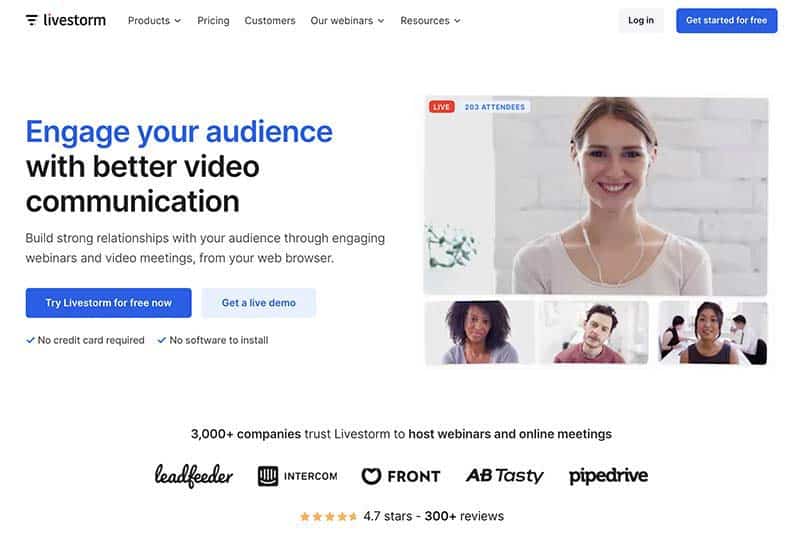
Livestorm is an excellent webinar tool that’s amazing for product demos and sales. Their software works on any browser without any restrictions on the size of your webinar. It can also be accessed from any device, including PCs, laptops, tablets, and mobile phones.
With their tool, you can run live, on-demand, or automated webinars. Webinars are great for live events like product demos, customer training, and other technical sales topics.
Their on-demand and automated webinars work best for online courses, employee onboarding, and video podcast interviews.
An area where it stands out is email logistics where you can send promotional emails, automate those emails, check email status, and add a touch of personalization. This webinar tool also takes your data security very seriously and is 100% GDPR-compliant.
Livestorm is also focused on customer engagement with activities like polling, Q&A sessions, and the use of up-votes.
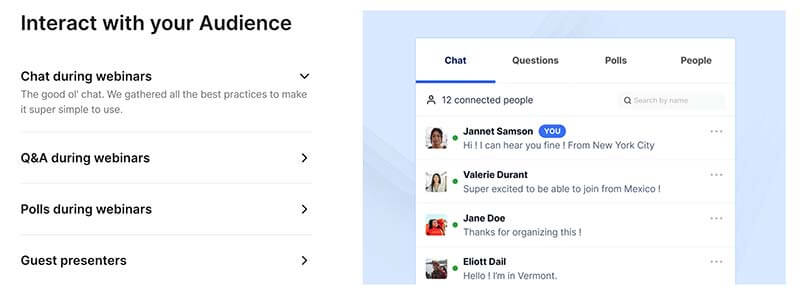
They also make it really easy for people to join your webinars. They don’t need to register or create a specific account – they can simply join with one click and an internet connection.
Key Features:
- Provides access to highly adaptable webinar themes with an easy set-up process.
- Offers interactive chats with polls, questions, chat, and more for better customer experience.
- Great for product demos and 1:1 meetings to qualify leads and improve your sales process.
- Integrate and analyze webinars and video meetings.
- It provides a high level of automation with webinar sequences.
- Offers comprehensive, multi-language customer support.
- It comes with features like a one-click invitation, screen-sharing, the ability to embed registration forms, and more.
- Livesorm offers a freemium plan with essential features.
- Provides detailed attendance analytics, replay analytics, source tracking, and participation report.
- Unlimited recording storage.
- It allows you to export your data as CSV or XLS.
- It enables you to use Zapier and integrates with more than 1,000 apps.
- Display in-webinar CTAs to influence viewers to act.
Pricing Plans:
Livestorm offers three pricing plans.

Webinar & Meet Basic: The first plan is a freemium plan and comes with essential features like unlimited on-demand webinars, meetings, etc.
Meet Premium: The ‘Meet Premium’ plan costs $31/host per month and allows up to 8 participants.
Webinar Premium: The ‘Webinar Premium’ plan costs $99/host per month and has a 4-hour limit per webinar.
Enterprise: There’s also the ‘Enterprise’ plan. It offers features like managing multiple workspaces with unified billing, premium training, and SLA availability. Here, you get a personalized quote based on your requirements.
Overall, they are a high-quality tool and their live features are great for product demos and sales training.
You can get started with Livestorm for free and upgrade to a premium plan for more participants.
2. Demio.
Best Webinar Software for Marketing (25% Off).

Demio is my #2 pick and has a great combination of no-download webinars for your audience and marketing tools to generate more leads.
When it comes to visual aesthetics, it delivers real-time, HD streaming video, and a great-looking platform.
Everything is customized to match your brand and they have all the video conferencing features you need: live and automated webinars, replays, registration landing pages, etc.
All pricing plans offer great standard features including advanced webinar setup, 24/7 chat and email support, unlimited webinars, storage for 100 recordings, and robust analytics.
KEY FEATURES:
- Automatic, cloud-based webinar events and recordings.
- Chats, polls, handouts, and a great waiting room experience.
- Offers built-in analytics and insights.
- It can be easily integrated with other marketing tools.
- Email automation and event reminders.
PRICING PACKAGES:

Demio provides a 14-day free trial, which allows you to test out all its features. Here’s a breakdown of their paid plans.
- Starter Plan: $34 per month for a 50-person webinar room
- Growth Plan: $69 for a 150-person room
- Business Plan: $163 per month for a 500-person room.
Overall, if you’re looking to run more effective webinars with built-in marketing tools and no downloads required, give Demio a try.
Use promo code ADAMENFROY25 to receive 25% off your first month on all monthly plans.
3. WebinarJam.
Best for Selling Products with In-Webinar Pop-Ups (14-Day Trial for $1).

WebinarJam is #3 on my list of the best webinar software currently available. If you have little to no technical knowledge regarding how to set up a webinar, then this easy-to-use webinar platform has you covered.
Additionally, it allows you to stream directly to a YouTube page, and have a secure, password-protected meeting with your target audience online.
It also offers some distinct advantages over other tools, such as:
- Providing pop-ups to your audience during the webinar session itself, which allows them to buy your product or service right from the webinar
- Offering excellent two-way communication via advanced Live Chat which pulls a video of the participant for 1:1 video communication
WebinarJam employs a unique and distinct Broadcast Distribution Technology which creates a universal signal. Besides, it uses all the latest technology, like RTMP, WebRTC, HLS, and Flash, which makes it compatible with almost all web browsers and devices.
You also get other impressive features, such as HD video, customer-facing interfaces, user-friendly dashboards, and the option of multiple presenters.
Every recording is automatically recorded so that the replay can be sent to your audience. Additionally, the tool is extremely easy to use and they have training videos to help every step of the way.
You can read my full review of WebinarJam here.
KEY FEATURES:
- Automatic recording.
- It offers great customer support.
- Built-in autoresponder.
- Social media integrations.
- Has the ability to handle multiple attendants easily.
- Compatibility with various browsers and operating systems.
- It allows you to incorporate polls and surveys with your webinar.
- Extremely easy to use, with user-friendly dashboards and interfaces.
- Quick set up process; it takes about 60 seconds to get up and running.
PRICING PACKAGES:
- Basic Plan: $499/year ($41.58/month). This plan gives you up to 500 participants per webinar, up to 3 presenters, and 24/7 support.
- Professional Plan: $699/year ($58.25/month). With the pro plan, participants increase to 1,000, and speakers go up to 4.
- Premium Plan: $999/year ($83.25/month). This plan is for businesses that rely heavily on webinars for their online marketing. It features up to 6 speakers and a webinar audience of up to 5,000.
Overall, based on features, ease of use, support and training, and a 30-day money-back guarantee, WebinarJam is one of my top picks this year.
Secret: You can get started with a 14-day trial of WebinarJam for $1 to test out its features. Go to their pricing page and hover your mouse near the top of the screen to fire their exit-intent pop-up with this offer.
4. WebinarNinja.
Best Platform for High-End Coaches ($39/month).
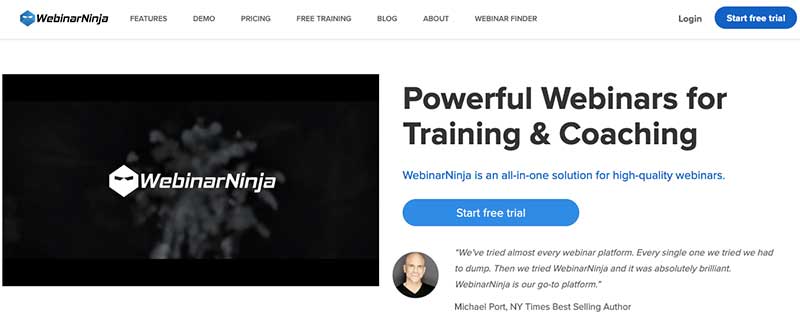
WebinarNinja is a powerful, all-in-one solution trusted by major brands like AppSumo, Podia, Printful, and more. They are known as one of the easiest tools to use, with out-of-the-box thank you and sign-up pages, allowing you to create a webinar in under a minute.
WebinarNinja allows you to create four different types of webinars:
- Live – broadcasted with a live host for audience interaction.
- Automated – recorded webinars that run at certain times or on-demand.
- Series – a group of several webinars.
- Hybrid – a combination of live and recorded videos.
KEY FEATURES:
- Lightning-fast live chat.
- Instant screen sharing.
- Run multiple polls before, during, and after the webinar.
- Timed offers to display at any time during your webinar.
- Email automation and drip campaigns.
- High-converting, custom registration landing pages.
- Analytics dashboard with the ability to export data.
- Integrations with 1,000+ apps with Zapier.
PRICING PACKAGES:
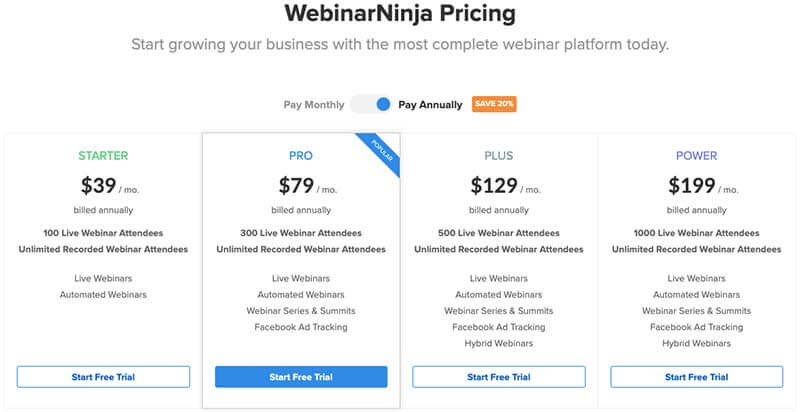
WebinarNinja comes with a 14-day free trial to test out its features. It also features four paid plans:
- Its Starter Plan is $39/month and works well for users that only require 100 webinar viewers.
- Next, their most popular Pro Plan is $79/month and adds another 200 attendees, plus the ability to create a webinar series.
- They also have a Plus Plan at $129/month and a Power Plan at $199/month with more advanced features.
These higher-tier plans allow hybrid webinars (a series of live and recorded webinars) and more live viewers at once.
Overall, WebinarNinja is a great tool for those looking for both advanced features and the ability to create webinars fast.
Try out WebinarNinja and get a 14-day free trial.
5. GoToWebinar.
Best Web Conferencing Software for Large Organizations ($89/month).
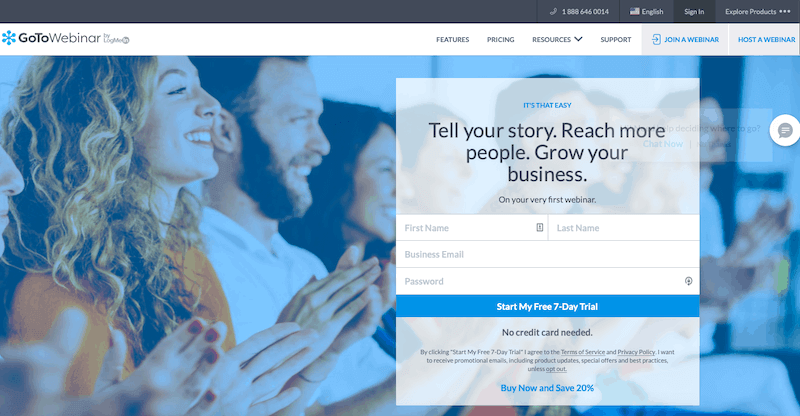
The next webinar software on my list is GoToWebinar. With GoToWebinar, you don’t have to worry about the clutter and confusion that comes with organizing your webinar and can just focus on reaching more people and growing your business.
All that you do is choose the date you want to host your webinar, and it takes care of everything else.
It also exposes you to a variety of features to improve your webinar experience, ranging from flexible scheduling to the entire event management process. You also have access to several in-built webinar templates that provide the ultimate business environment.
Moreover, with impressive features such as automated email reminders, customizable webinar invitations, and a highly converting registration page, you can now promote your upcoming event and drive massive traffic. Other features include in-built polls and surveys, automatic webinar recordings, and more.
KEY FEATURES:
- Pre-recorded events.
- Robust analytics.
- HD video quality.
- 24/7 customer support.
- Integrations with GoToMeeting.
- In-built polls and surveys to engage your audience.
- Automatic recording, which can then be shared online.
- Seamless integration with tools such as Zapier, Salesforce, Unbounce, etc.
- Source tracking to discover which channel resulted in maximum webinar signups.
PRICING PACKAGES:
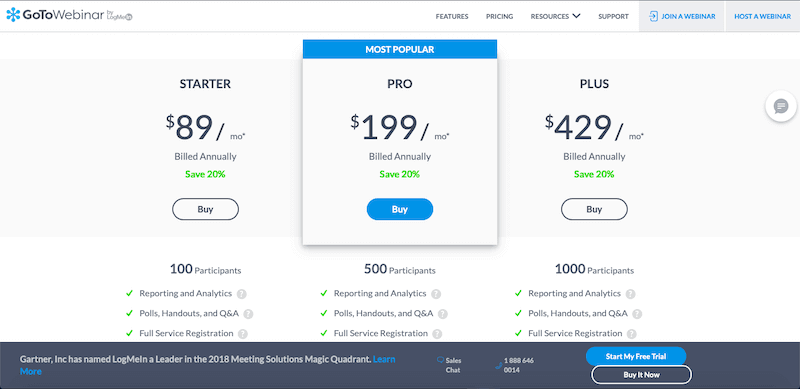
The Starter plan costs $89 per month for 100 participants, $199 per month for 500 participants, and $429 per month for 1,000 people, all for annual subscriptions. You can also start a free trial with up to 100 people; no credit card required.
CONS:
- The Starter plan limits the attendance count to 100.
- Comes with a higher price than some other tools on this list.
6. LiveWebinar.
Best for Live Streaming (Free – $95.20/month)
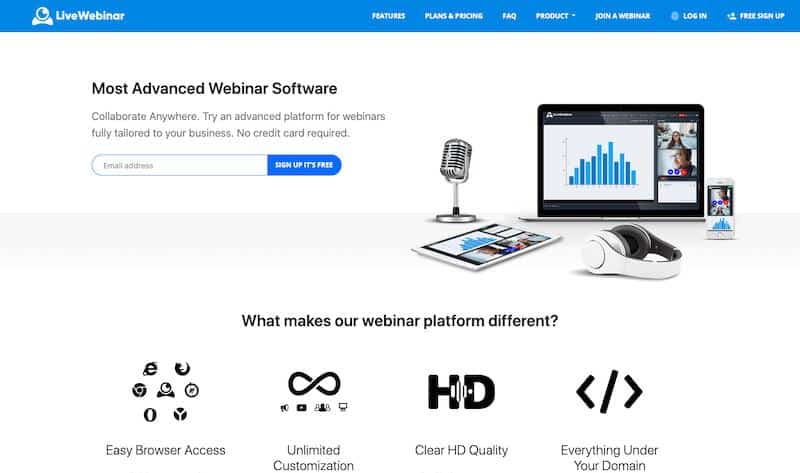
LiveWebinar is a cloud-based webinar tool that lets you host webinars, share screens, stream live videos, record your screen, social media broadcasting, and more. It has over 42 data centers, over 99% SLA, and can host over 1000 participants.
You can join and conduct webinars without installing or downloading their application – directly from internet browsers like Chrome, Opera, Firefox, etc. Plus, the ability to embed webinars into your website helps you conduct or display webinars straight to your site visitors. The tool integrates with several platforms like emails, phone, and text messages to help you invite members to your upcoming webinar.
The webinar platform helps you stream live on all social media platforms like Facebook, Youtube, Vimeo, etc. You can even connect it and work from all devices, including Smart TVs, PCs, and mobile phones.
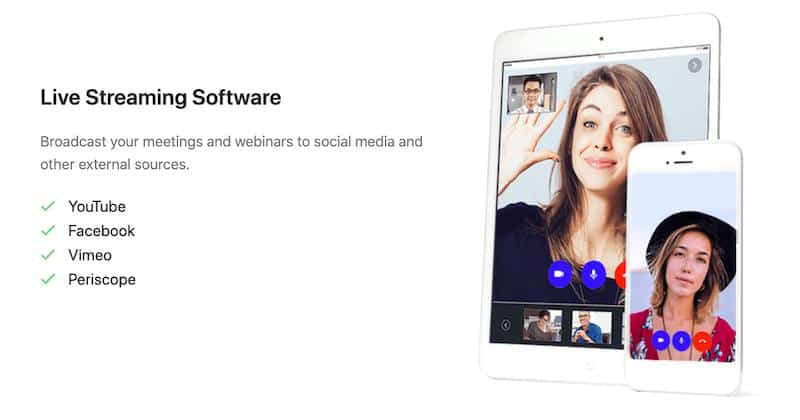
LiveWebinar gives you the option to record either the full webinar or some part of the webinar in HD quality. You can then share it with whoever you want or embed on any platform you like, including your site or other external platforms.
You can also share your desktop screen during live streams and webinars in real-time with a single click.
It also lets you monitor audience engagement analytics and create and share advanced reports and statistics.
You can chat with your attendees, conduct polls and surveys to engage your audience while conduction the webinar. There’s also an option to include call-to-action buttons to encourage participants to take any action and convert more leads.
The ability to assign roles to different employees or colleagues also comes in handy. This way, you can manage various tasks during the webinar or while live streaming.
Additionally, you can customize your webinars according to your choice with different templates, colors, and your own branding elements.
Integrations include all the primary marketing automation tools like MailChimp, Campaign Monitor, FreshMail, Slack, etc.
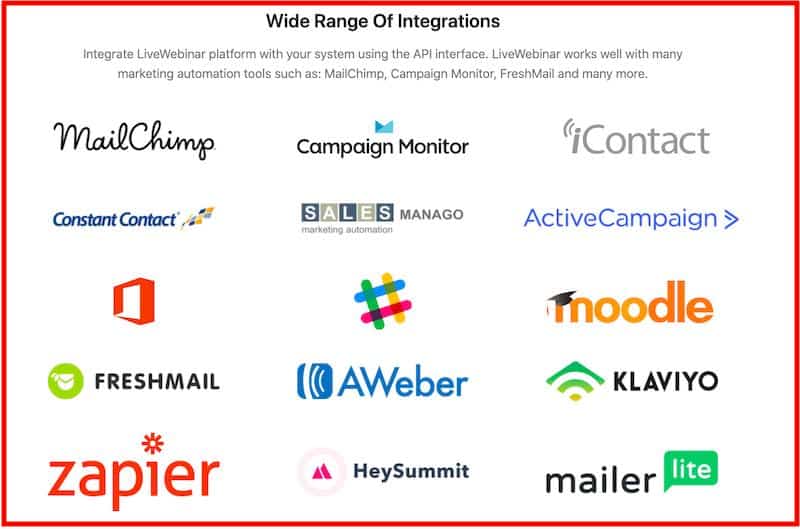
Key Features:
- The WhiteBoard feature helps you express your ideas by drawing on documents and videos. You can invite your viewers to draw as well.
- Add Prezi forms in your Webinars.
- Split your main room into smaller breakout rooms, even during live meetings.
- It lets you host up to 1000 attendees.
- There’s a freemium for up to 5 attendees.
- All the pricing plans come with a 14-days free trial.
- You can embed Ads-banner into your webinars.
- Translates chats in real-time into the language you prefer.
- You can include tests, surveys, and polls while conducting your webinar.
- Play your YouTube video in your webinar rooms.
Pricing:
LiveWebinar provides the following four pricing plans:
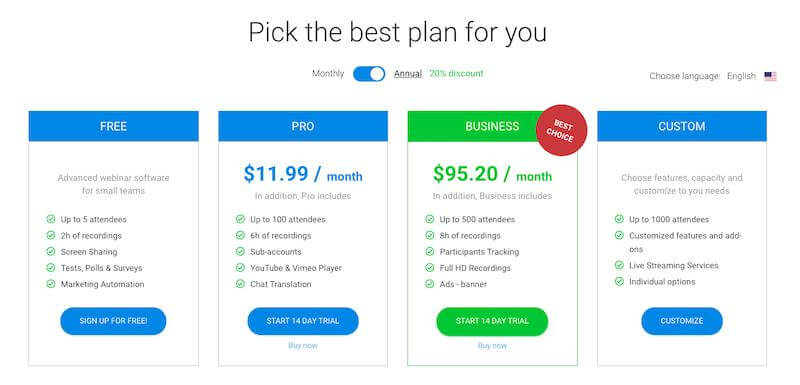
- Free: $0 per month (for up to 5 attendees)
- Pro: $11.99 per month (for up to 100 attendees)
- Business: $95.20 per month (for up to 500 attendees)
- Custom: Custom pricing (for over 1000 attendees)
All plans include features like Prezi presentations, the ability to add tests, polls & surveys, email invitations, whiteboard, screen-sharing, and more.
You can get started with a 14-day trial.
7. EverWebinar.
Best Automation Features (60-Day Trial for $1).

Touted as the “most powerful automated webinar platform,” EverWebinar is one of the most popular tools on this list. It is built with direct integration to WebinarJam, although the parent company sells them separately or in a bundle.
Some of its features include fully automated customer-activity based email connections, the ability to keep users in the loop, and complete set up under three minutes for WebinarJam users. Also, it records the webinars automatically so that the user can replay them for potential leads.
EverWebinar is best suited to small and medium businesses looking to generate leads and boost their sales using Webinars.
KEY FEATURES:
- One-click platform swap between WebinarJam and EverWebinar.
- It allows you to fake your audience count.
- Performance stats in real-time.
- Convert past live events into evergreen events.
- Just-in-time webinars that start right away upon registration.
- An advanced scheduling system that helps block out unavailable dates.
- Time-zone auto-detection for the ease of users all over the globe.
- Unlimited free hosting via reliable, cloud-based servers.
PRICING PACKAGES:
It costs $41 per month (billed annually), which is the middle of the pack. However, the features it provides along with the partnership with WebinarJam makes it worthwhile.
Get a 60-day trial of EverWebinar for just $1.
8. BlueJeans.
Best for Large Virtual Events and Townhalls ($83/month).
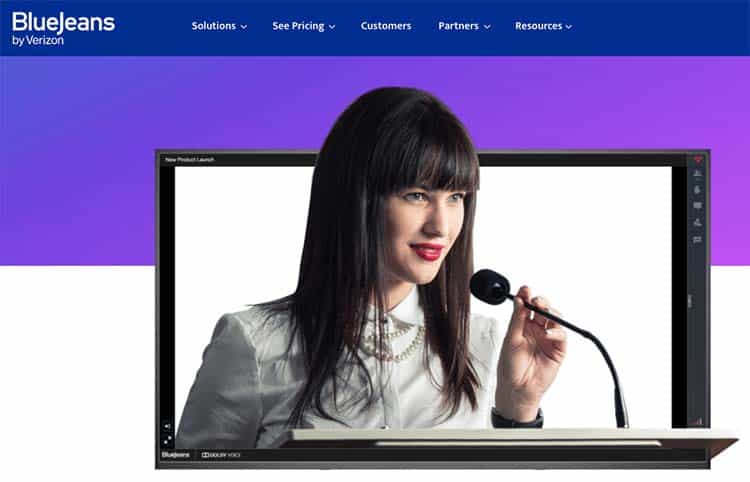
BlueJeans is a video conferencing tool that has four distinct products, one being BlueJeans Events. This virtual event tool can be used to host events for large global audiences, like live streams, interactive events, and townhalls.
This production-grade platform can host up to 50,000 attendees and provides unique content experiences like Q and As, immersive video, and live polling.
Back when I worked in the tech industry, this tool would have been perfect to run our companies weekly employee all-hands meetings. BlueJeans Events provides a live, interactive open forum where ideas can be exchanged and huge audiences can share information.
Here’s how it works:
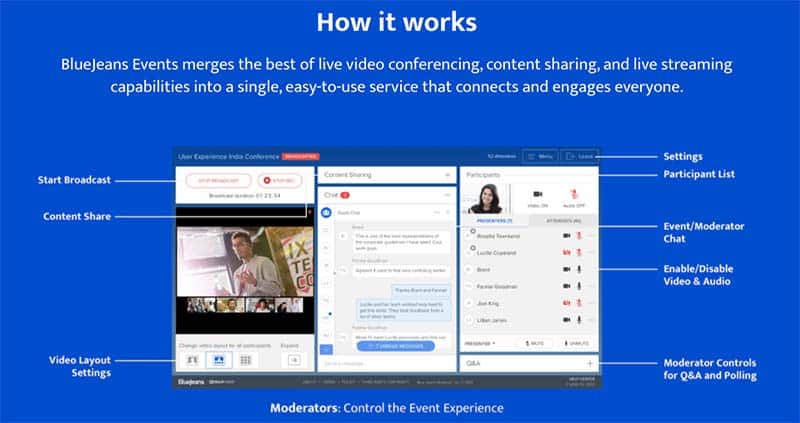
Within three interactive screens, you can start your broadcast, view the participant list, enable and disable audio, and have full moderator controls for Q and A and polling.
KEY FEATURES:
- Host worldwide events with 50,000 attendees and 150 presenters.
- Event cloud recording.
- Easy moderator controls to manage the event.
- Works from any device without downloading an app.
- Can live stream to Facebook Live.
- Post-event analytics reports.
- A/V equipment recommendations and specs.
- 24/7 premium support.
PRICING:
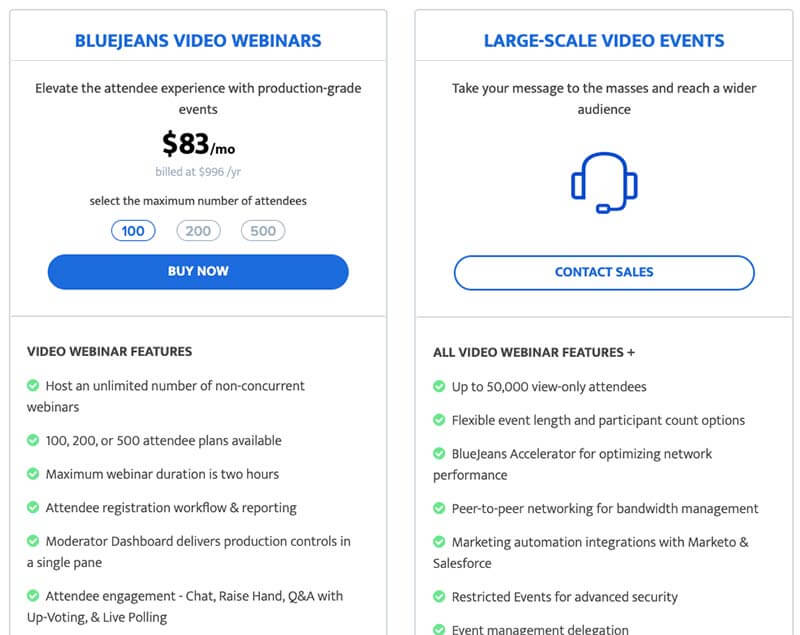
BlueJeans Events starts at $83 per month (when paid annually). This provides up to 100 attendees, engagement features, and a maximum webinar duration of two hours.
If you’re planning to host large events, townhalls, and all-hands meetings for a global audience, BlueJeans is your top pick.
9. My Own Conference.
Great for Scheduling Multiple-Webinars to Small Groups (Free – $30/month and up).
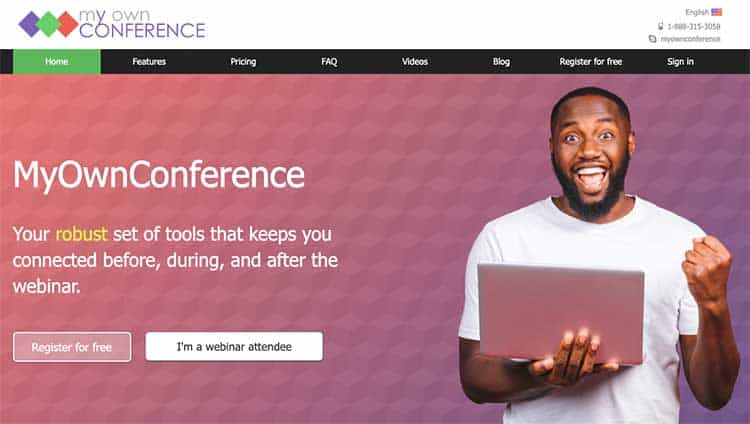
My Own Conference is a webinar tool that helps you connect with your audience before, during, and after the webinar.
Some of its standout features include their useful schedule view which lets you see multiple webinars in one place and their “always-on” webinar room.
While their tool is free for up to 20 attendees, one drawback is that it gets very expensive if you need more attendees. For example, if you want up to 5,000 attendees, you have to pay $1,920 per month.
I recommend this software if you’re looking for a cheap team collaboration tool to hold multiple webinars to a small audience.
KEY FEATURES:
- Record your webinars in full HD and send them to attendees.
- Video conferencing and screen sharing features for teams.
- Instant messaging capabilities during webinars.
- No download required for attendees.
- You can share videos and YouTube videos during your broadcast.
- Online quizzes can test your audience’s knowledge.
- White label solutions for agencies and brands.
- 16 languages supported.
PRICING:
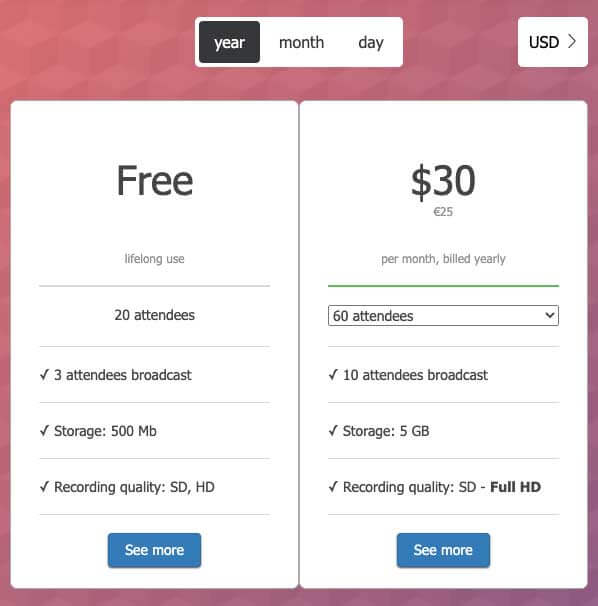
My Own Conference is free for up to 20 attendees and 3 broadcasters. The free plan also includes 500 MB of storage and standard HD quality.
Paid plans scale based on attendee counts and provide access to more storage and full HD videos. For example, 60 attendees is $30/month, 150 is $51/month, and 1,000 is $250/month.
Get started with My Own Conference for free.
10. EasyWebinar.
Most User-Friendly Webinar Software ($59/month).

EasyWebinar is the only online software platform that has successfully and seamlessly managed to integrate webinar technology with marketing strategy.
Moreover, it provides an all-in-one solution for both live and automated webinars. The webinar software offers tons of other features, including a multi-presenter option, integration with popular email marketing software, shopping carts, and lead generation tools.
KEY FEATURES:
- Screen-sharing options, HD video, and interactive live chat.
- Allows up to 100 attendees even in the basic plan.
- Unlimited live viewers using YouTube Live Integration.
- Robust chat features and a mobile app available.
- WordPress integration.
- In-built analytics suite.
- It allows integration with popular tools like MailChimp, GetResponse, etc.
PACKAGES:

The Standard pack costs $59 per month, which is billed annually at $708; the Pro plan is $90 per month, and the Enterprise plan is $349 per month. If you have over 10,000 attendees, then you can get in touch with them for quote-based pricing.
11. ClickMeeting.
Best Tool for Education Features ($25/month).

ClickMeeting is one of the most popular webinar software platforms in this list, with an impressive and user-friendly interface.
ClickMeeting makes it easier for you to reach out to your customers for training, product sales and marketing, and other aspects. All in all, it is a well-integrated, intuitive platform that provides options for automated webinars and customized invites.
Best suited for small and medium-sized businesses, ClickMeeting provides clear instructions to set up the event effortlessly, without worrying over any technical stuff. It also offers analytical insights regarding the past webinars and the audience of the upcoming webinar.
KEY FEATURES:
- Offers polls and surveys for feedback.
- Chat options and interactive sessions.
- It can be connected to Facebook and YouTube to enhance engagement.
- You can record the entire audio and video of the live sessions, which are then stored in clouds, and can be downloaded easily.
- Multiple presenters can present with HD video.
PRICING PACKAGES:

ClickMeeting’s rates start at $25 per month (billed annually) for 25 attendees or $35 (billed annually) per month for up to 50 viewers. There’s also an option for custom-pricing that’s best suited for enterprise customers.
ClickMeeting also has a free 30-day trial to test out its features.
12. BigMarker.
Best Interactive Software for Summits and Virtual Conferences ($79/month and up).
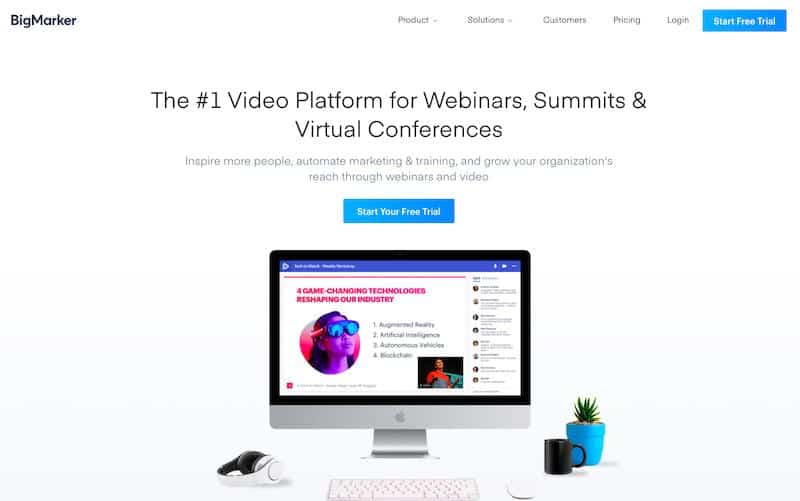
BigMarker is known as the #1 video platform for webinars, summits, and virtual conferences.
Their live streaming capabilities are where they really excel. You can engage up to 10,000 people at once and create an interactive experience with features like polls, handouts, and live Q and As.
There are also no limits on the number of presenters in the webinar – literally anyone can hop in and join the discussion on screen.
To host these live events, you’re provided with a suite of marketing tools, including custom email invites, registration landing pages, and helpful reminders.
With their automated webinars, you can integrate BigMarker with your CRM software to qualify prospects and generate, nurture, and convert your leads.
Here are some ways you can drive sales with BigMarker:
- Create automated webinars to fill your top-of-funnel leads.
- Capture your prospects’ data with embedded forms, surveys, and polls.
- Move prospects down the sales funnel by easily booking meetings based on their data and lead status.
With BigMarker, you also get extensive third-party integrations with apps like MailChimp, Calendly, Marketo, and more. And integrations with payment providers like Stripe make it easy for you to manage transactions.
Since it’s a browser-based platform, you don’t need to download or install anything to get into a webinar. On top of that, it’s compatible with PCs, laptops, tablets, and mobile devices.
Another area they excel in is their white-label offerings. You can build custom video experiences and embed them right on your website with no coding required. These landing pages, webinars, and emails all live on your own domain so that you own the customer experience.
Key Features:
- Offers unique live streaming features like one-click meetings, Q&A sessions, chats, polls, handouts, etc.
- It comes with extensive native integrations with apps like Salesforce, Hubspot, Zapier, etc.
- It provides a 7-day free trial period.
- HD video and screen sharing.
- You can stream multiple camera feeds to Facebook & YouTube Live.
- Build custom live video experiences for online events.
- Offers white-labeled seminar rooms and landing pages.
- It provides over 15 different landing page types.
- Deals in 135+ currencies.
- It comes with industry-standard SSL and HTTPS encryption for data protection.
Pricing Plans:
BigMarker offers four plans, including Starter, Elite, Summit, and White Label.
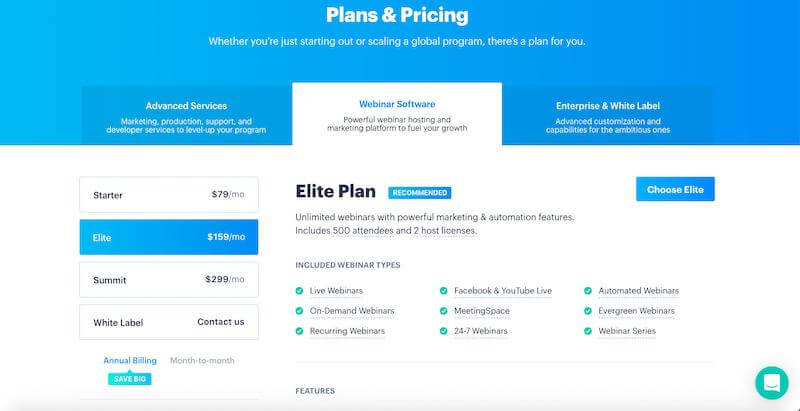
The first three plans cost $79, $159, and $299 per month respectively. The White Label plan is an enterprise-level plan, where you get a personalized quote based on your requirements.
The first three plans allow sequentially 100 attendees and one host license, 500 and two host licenses, and 1,000 and four host licenses.
Every plan comes with features like in-depth analytical tools, pop-up offers, email templates, contact & list management, embeddable webinars, custom URL, and more.
If you’re looking for a webinar tool to run live events, workshops, town halls, and keynote presentations, BigMarker is a great choice because of its interactive video features and seamless performance.
Get started with a free 7-day trial of BigMarker.
13. GetResponse.
Best for Easy Email Marketing Integrations ($49/month).
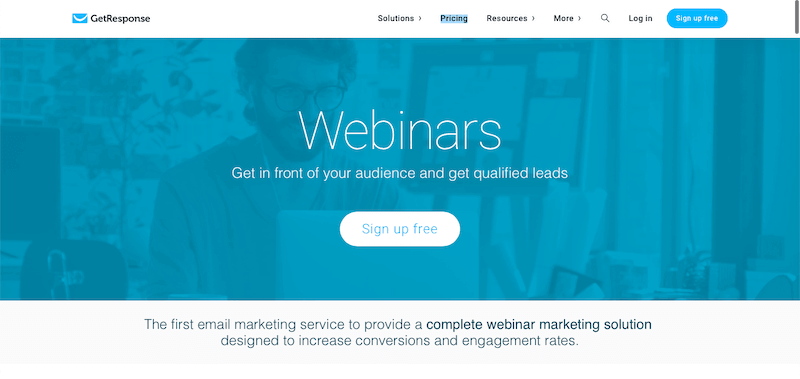
GetResponse is primarily an email marketing platform that offers a wide array of marketing solutions, including a complete webinar marketing solution.
It allows you to set up your webinar within three minutes, sometimes even less. Other marketing tools include autoresponders, automated email marketing, Landing pages, list segmentation, and more.
KEY FEATURES:
- It allows you to customize your webinar URL.
- Pre-existing webinar invitations and reminder templates with pre-filled webinar details.
- One-click webinar recording.
- Text chat feature to drive engagement.
- One-click sharing options.
- It allows you to set up autoresponders.
- Tracks conversion stats and provides detailed audience statistics.
PRICING PACKAGES:

GetResponse has a free 30-day trial and a Basic plan that doesn’t include webinar features. Their Plus plan is the first one that provides webinar solutions and starts at $49 per month for up to 100 attendees.
The Professional plan is $99 per month for up to 300 people and the Enterprise package is $1,199 for up to 500 people. However, it also includes email campaign consulting and a dedicated account manager.
CONS:
- Free-trial provides space for up to 1,000 contacts only.
- Customer support doesn’t include phone support.
- The pricing structure is somewhat complicated. The prices increase exponentially along with your list size.
14. Adobe Connect.
Best for Large Marketing Organizations and Agencies.
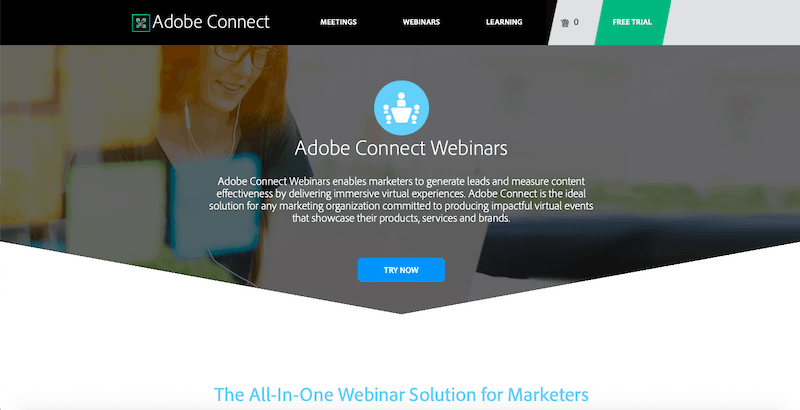
A frontrunner in innovation and technology, Adobe has forayed into webinar platforms with Adobe Connect Webinars.
Apart from creating webinars, it allows you to host videos, share documents, and host meetings for increased interaction with customers. Moreover, it will enable you to customize your hosting room and optimize it as per your requirement.
Adobe Connect helps marketing companies and firms showcase their products and services in an impactful way to their target audience.
KEY FEATURES:
- It provides a variety of templates to customize your virtual environments.
- It helps you create unique registration pages.
- Ability to influence and reach out to target audience with videos, blogs, surveys, and polls.
- It offers robust analytics for better insights.
- Integrates easily with CRM software like Eloqua and Salesforce.
PRICING PACKAGES:

Adobe Connect comes with a moderate price tag. For 100 seats, it is $130 per month, $470 per month for 500 seats, and $580 per month for 1,000 seats. Each plan allows you to host unlimited events. Moreover, you get a 30-day free trial to test out the product.
CONS:
- There have been some rare instances of display video and audio compatibility issues in mobile devices.
- One of the highest prices for webinar software.
15. WebinarsOnAir.
An Affordable Option for Mid-Tier Webinars.

If affordability is your main concern, then WebinarsOnAir is the perfect platform for you. On top of that, it comes with all the fantastic features required to host an excellent webinar.
It’s also exceedingly user-friendly, for the host as well as the viewers. Offered by G Suite, it allows you to set up your own room. Moreover, it exposes you to a variety of exciting features, including recurring webinar options, polls, and surveys built into the webinar itself, Q and A, and so forth.
It is entirely hosted in the cloud, thus offering extensive scalability power. With WebinarsOnAir, you can also keep track of your audience count, conversion rate, and other vital metrics.
KEY FEATURES:
- You can schedule a webinar for up to 50,000 attendees in less than a minute.
- Offers “Tracking Pixels,” which allows you to create “laser-targeted audiences for retargeting purposes.”
- Live Q&A sessions along with live-chats.
- Allows 10 moderators/speakers at once.
- One-click webinar registration.
- Offers in-built opt-in forms.
- Cloud-based hosting.
PRICING PACKAGES:
30-day free trial. The plan for 25 viewers costs $19.97 per month. For unlimited participants, the plan costs $99 per month.
16. Google Hangouts.

One of the most popular names on this list, Google Hangouts is a completely free solution that easily integrates with the Chrome Browser and Gmail. You can either host a webinar for up to 30 prospects or stream it on YouTube to invite a larger audience base.
Google Hangouts is one of the best free software choices because it caters to every business size, whether a small or medium-sized business or a large corporation. It also allows several people to speak and share their screen during the webinar, and record the meetings.
Since it’s free, there are some main downsides compared to other tools on this list. For example, while it’s good for quick 1:1 meetings, you don’t get any automation or marketing features.
KEY FEATURES:
- Allows up to 30 people in the chat.
- Several speakers can speak during the webinar.
- Completely free of cost.
- The recording is done automatically and uploaded on your YouTube channel right away.
- It can create a webinar in 10 seconds.
- Integrates with YouTube and Chrome.
- No additional software download needed.
- Easy screenshare features.
PRICING PACKAGES:
Free, but limited for those looking to optimize their sales funnel.
CONS:
- A Google account is a necessary prerequisite.
- Unlike other tools on this list, Google Hangouts does not offer any other additional marketing features, such as analytics, paid events, email marketing, etc.
17. Livestream.

Livestream is an excellent webinar tool primarily catering to big businesses and educational institutions. It’s best suited for organizations that have already engaged and built a relationship with their target audience.
There’s no maximum limit to the number of attendees; an unlimited number of participants can view your webinar.
One of the best parts about Livestream is that it offers unlimited storage and automatically records and stores all your webinar events in the cloud. Other prominent features include limitless streaming analytics, the ability to stream to Facebook Live or YouTube, live Q&A and polls, audience chat, lead generation tools, and so forth.
You also get dedicated phone support for your webinar events and can even privatize your event’s access.
KEY FEATURES:
- Unlimited storage and unlimited viewers.
- Impressive customer support.
- It allows you to privatize your events.
- Private link sharing.
- Extensive in-built analytics.
- Stream to Facebook Live or YouTube.
- You can embed the webinar into your website.
PRICING PACKAGES:

It costs $75 per month if billed annually. Livestream also offers a quote-based Enterprise package that offers additional features such as, dedicated account manager, auto-archiving, pay-per-view option, and more.
CONS:
- Some reviews suggest that there are some rare occurrences of connectivity lags.
- They don’t offer a free trial.
18. Zoom.
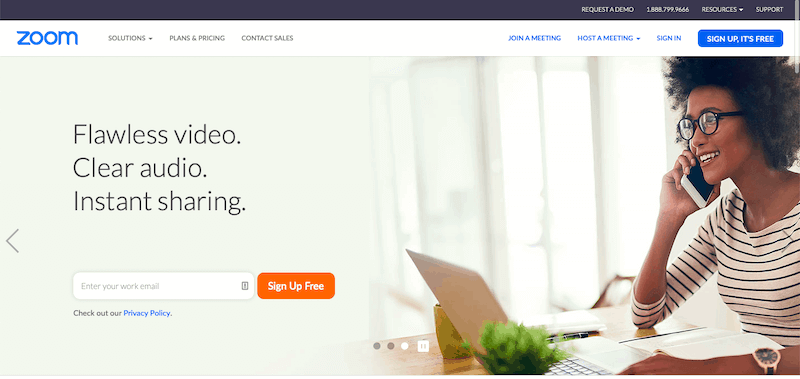
Zoom is the most popular webinar software on the market today, connecting friends and colleagues worldwide across different time zones.
Some reasons to use Zoom is that it’s intuitive, entirely cloud-based, and has a user-friendly interface that makes things easy for its users.
It performs a wide array of activities that make it an asset to any company. Zoom offers HD video and audio, screen sharing, desktop, and app sharing options.
Moreover, it allows you to host the scheduled and unscheduled meeting, and keeps a backup of every session in the cloud for ready and instant access at a later time.
Their web conferencing software also allows private and public chats so that the audience does not necessarily have to interrupt the speaker while he or she is making a point.
It also integrates with Google Calendar and Microsoft Outlook, which allows its users to schedule meetings and send emails, seamlessly. Zoom is a one-stop-shop for everything when it comes to hosting a webinar event.
KEY FEATURES:
- HD video and audio, along with screens sharing facility.
- Desktop and app sharing options.
- Backup of every meeting in the cloud.
- It allows private and public chats, which lets your viewers communicate during the event without any interruption.
- Provides free access to up to 100 participants and 40 mins limit on group meetings.
- Efficient host controls and virtual whiteboards.
- User-friendly and easily navigable dashboard.
- There are no one-time fees and it’s free to sign up.
PRICING PACKAGES:
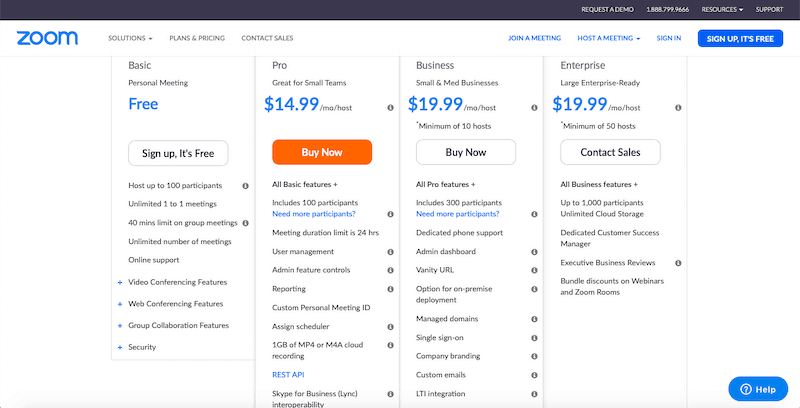
It is one of the best webinar platforms that provide a freemium package. The free plan offers 40 minutes on the webinar and allows up to 100 participants. The Basic paid plan offers every feature along with 1 GB of cloud recording and costs $14.99 per month.
The Business package, ideal for small and medium-sized businesses, is $19.99 per month. The Enterprise package, which is best suited for large enterprises, costs $19.99 per month.
CONS:
- Some reviews suggest that the audio quality should be improved.
- Some users have complained that the calls get automatically disconnected sometimes.
- Zoom isn’t higher on this list because while it’s great for quick meetings, it doesn’t have the deep marketing and automation features that others tools on this list have.
Check out my full review of Zoom vs. GoToMeeting vs. Webex vs. WebinarJam to see how it stacks up against other top video conferencing apps.
19. AnyMeeting.
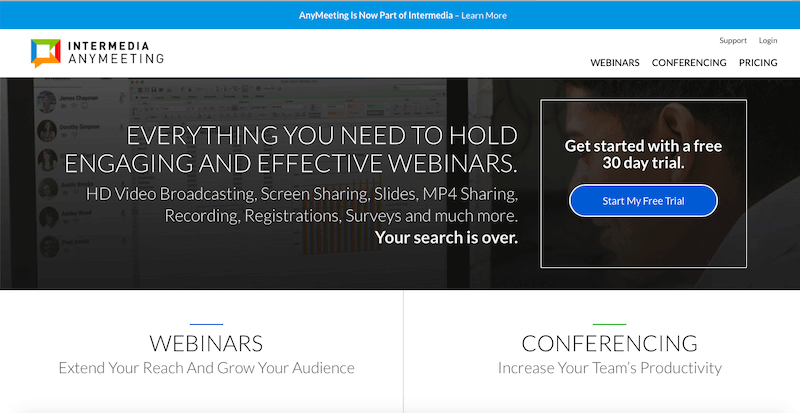
Perfect for small organizations, startups, and educational institutes, AnyMeeting offers essential tools to host your webinar along with a user-friendly and intuitive interface. It’s powered with some strong features, such as HD video broadcasting, screen sharing, MP4 sharing, in-built surveys, automatic webinar recording, and more.
AnyMeeting offers varied pricing packages that allow you to host up to 1,000 attendees. You also get a 30-day free trial to test out the webinar platform and check whether it aligns with your preference.
Along with the Webinar hosting options, AnyMeeting also provides web conferencing tools that allow you to conduct collaborative sessions with your fellow team members, prospects, to clients.
KEY FEATURES:
- Up to 6 live speakers and up to 1,000 participants.
- Provide options for real-time audience chat.
- Offers in-built Q&A sessions, live-chat, polls, surveys to engage your audience.
- Follows-up with your attendees via emails.
- Intuitive and user-friendly interface.
- A free 30-day trial at the start, so that you make sure that the environment suits you.
- It offers robust analytics and built-in reporting.
PRICING PACKAGES:

The basic plan called Webinar Lite is $48 per month for 50 viewers; Webinar Pro that allows up to 200 viewers is $128 per month and $298 per month for the Webinar Enterprise plan that allows up to 1,000 people.
CONS:
- Some would say it is a little overpriced, but the value it brings to the table makes it worthwhile.
- It does not allow broadcasting from mobile devices.
20. Webex.
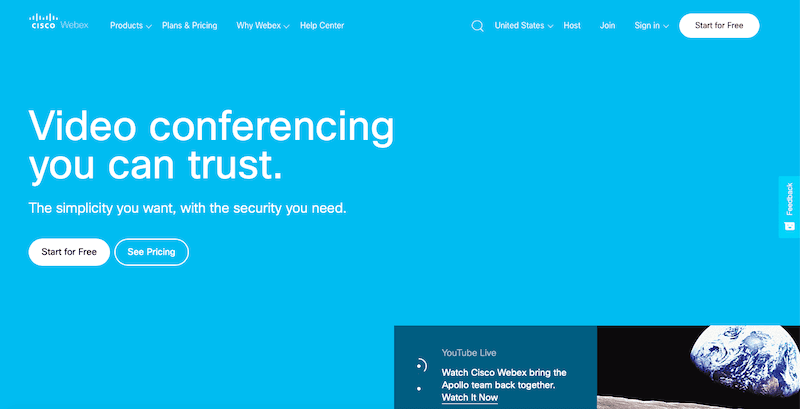
A Cisco product, Webex lives up to the expectations that come from having such an acclaimed parent company.
It provides some impressive features, such as a host room along with HD video and audio services that can be accessed on multiple devices. It allows its users a high degree of customization so that the host environment can be tailor-made to suit the business requirements.
Through Webex webinars, you can hold meetings throughout your organization, offer online and offline training sessions, and provide remote support. The key USPs of Webex include mobility, user-friendliness, and compatibility with all devices and browsers.
It is a cloud-based platform, so along with superior speed, there is a guarantee of data security as well.
KEY FEATURES:
- Cloud-based platform.
- It allows you to host up to 40,000 attendees.
- Built-in Q&A sessions, polls, and surveys to facilitate audience engagement.
- It provides a mobile app.
- Strong customer service.
- The excellent HD video and audio quality.
- Integrates with popular marketing tools like Salesforce.
PRICING PACKAGES:
The Basic plan costs $13.5 per month for up to 50 participants if billed annually. The price climbs up as you move on to a higher-tier plan.
CONS:
- More suited for in-house team collaboration than webinars.
21. DaCast.
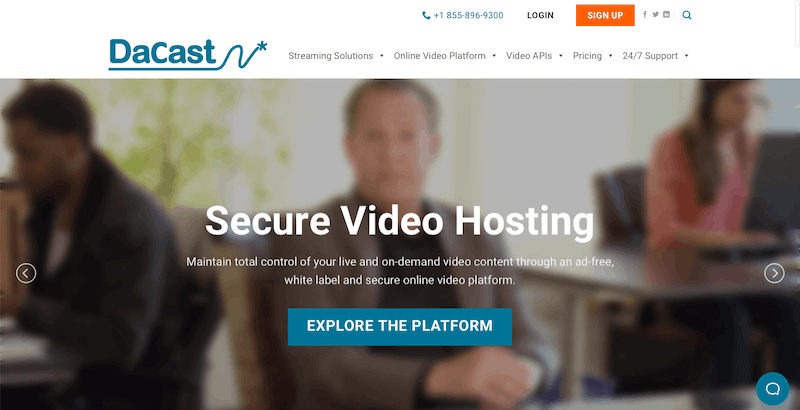
DaCast is another great webinar software platform in this list that helps you set up your online video conferencing environment within minutes. It offers impressive broadcasting features to help you manage, monetize, and analyze your online video.
Along with secure video hosting, you get 24/7 customer support that comes in handy if you get stuck in the process.
Popular features include the integration of live video with APIs and video streaming over social media platforms such as Facebook. With these features, you can shoot live webinars and then offer your on-demand webinars at a later date.
Simply put, it is a quick and easy-to-use platform that can be used even by novice marketers.
KEY FEATURES:
- No viewer limits.
- Allows FTP access.
- Real-time analytics.
- An interactive video on demand (VOD) solutions.
- Live streaming on social media platforms.
- User-friendly web conferencing interface.
- Easy to set up.
- Strong customer service.
PRICING PACKAGES:

The paid plans start at $19 per month (billed annually) for up to 300 viewers per hour and range up to $289 per month (billed annually) for up to 15,000 viewers per hour. There is one quote-based custom plan as well that allows you to cherry-pick the features you require.
CONS:
- Their webinar services are based on how much data you consume. If you go over the data bandwidth limit, you will be charged extra.
Full reviews of Zoho Meetings, Airmeet, and LogMeIn coming soon.
Our Top Picks.
That’s concludes our list of the best webinar software to use this year.
Here’s a quick summary of our top picks:
- Livestorm is the best webinar software overall.
- Demio is the best webinar software for marketing teams.
- WebinarJam is one of the best webinar platforms for sales funnels.
- WebinarNinja is the best webinar software for online coaches.
- BlueJeans is one of the best webinar software platforms for large events.
What is Webinar Software?
A webinar is a form of web conferencing that is essentially a blend of the words web and seminar. Webinar software runs this online video conference meeting. It’s better defined as a lecture, live presentation, meeting, or event that is conducted entirely online and attended by an exclusive audience.
The software that is used to run and conduct a webinar is webinar software. These webinar tools help you make your webinars more interactive, engaging, and flexible.
There are multiple options on the market, including Livestorm, Demio, Webinarjam, and more.
The best webinar software makes it easy to record, share, and follow up with your prospects without any difficulties or downtime.
In my opinion, the best webinar software tools are Livestorm, Demio, WebinarJam, Webinarninja, and GoToWebinar.
Overall, a webinar tool for small businesses should help you deliver live high-quality video and sync with your email lists. It should also help you automate your sales process and engage with your MQLs with live training and product demos.
Plus, most video conferencing tools come with features like built-in surveys, polls, email marketing software, live-chat features, automated webinar sequences, streaming capabilities, and more.
These automated webinar sequences are excellent for hosting evergreen content like online courses, podcast interviews, or employee onboarding videos.
What Are the Benefits of Webinar Software?
There are many benefits of using webinar tools to host your event or presentation.
Here are some of the top benefits:
1. Webinar Software is Cost-Effective.
Webinars cater specifically to an online audience of people who are already interested in what you’re selling. And unlike webcasts, there’s no physical location necessary for everyone to join.
Thus, you don’t need to pay for many of the things a physical seminar would entail, like renting a room and paying for space.
The attendees don’t have to pay much (if anything) to attend these online meetings, and they make excellent business sense for them, too.
The only things you need for a live webinar are:
- A webcam.
- A script with engaging content.
- A good internet connection.
- A set of interested people.
- Good webinar software to host and record your webinar.
- Either a nice microphone or just an internal computer microphone.
- Guest speakers and assistants with expertise.
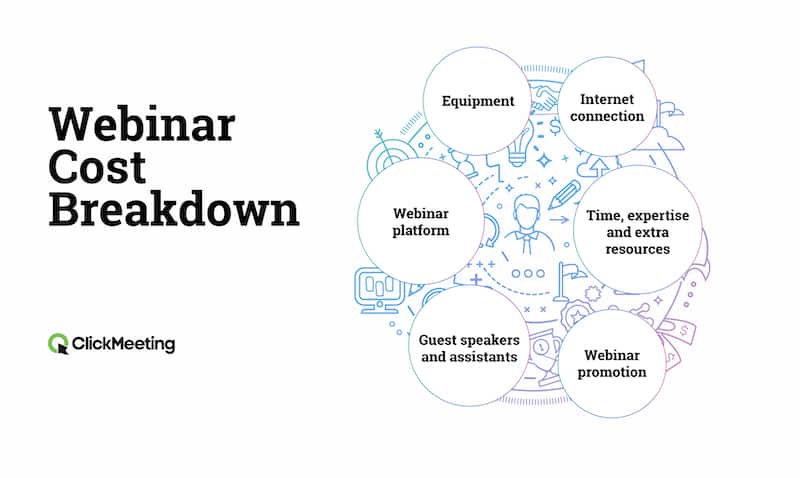
The cost of arranging a webinar is usually between $100 to $3,000, which is a fraction of the cost of organizing a live, physical conference.
However, if you use a webinar tool like WebinarJam, you can save yourself a lot of money as it only costs $1 for a 14-day trial.
Thus, it’s a very cost-effective medium of engaging your prospective leads.
2. Webinar Platforms Expand Your Audience.
Using software to create your webinars can help you do away with the problems of social media integrations and setting up billing.
All of these platforms allow you to reach an expansive audience all over the world, no matter where you are.
The logistical cost of attracting people from all over the world for an in-person conference isn’t possible in most cases unless a 6, 7 or 8 figure deal is agreed upon. That’s beyond the reach of most small and medium-sized businesses.
Webinars, on the other hand, allow you to target prospective leads all across the globe at virtually no logistical cost or support involved, no matter what the size of your business.
3. Webinar Software Improves Lead Generation.
According to statistics, 73% of B2B marketers and sales leaders suggest that webinars are the best way to generate high-quality leads.
With the right strategy in place, you can turn your webinar into a well-oiled and automated machine, churning out leads over time.
The webinar participants usually attend it due to their professional or personal interests. While not everyone is a potential customer, it’s vital to recognize who they are and target them via email based on their interests and actions.
Most webinar software offers lead generation and marketing tools that help you soft-sell your products, focus on the value they create, and steer your users down the sales funnel.
Take EverWebinar, for instance:
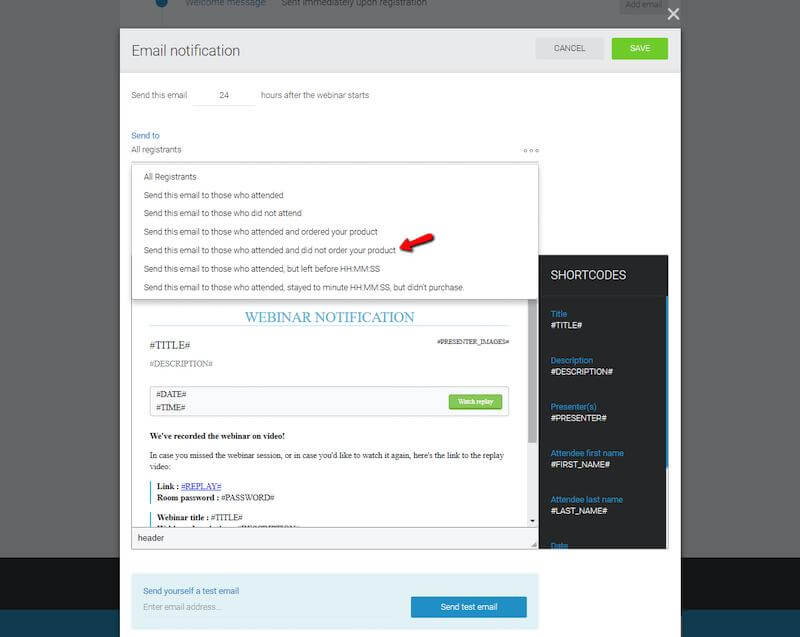
They help you send automated follow-up emails, communicate with your subscribers before and after the webinar, and allow you to customize your messaging.
All these amazing features help you generate more leads than you could ever do if you host a regular webinar.
4. Webinar Platforms Allow Guest Presenters.
Webinars open up plenty of ways to create engaging and enriching presentations for your potential customers. One way to generate interest is by inviting guest speakers on your webinars.
Getting a guest speaker on-board is an excellent way to boost your credibility. Naturally, industry experts endorsing a webinar usually builds trust with your audience.
Moreover, an industry leader is likely to have a lot of peer interaction and a large professional following. By getting an influential member of the industry to speak on your behalf, you stand a great chance of tapping into their entire contact list.
Most webinar platforms give you the option of hosting webinars with multiple presenters, which allows you to invite some influential guests to engage a wider audience.
One example is WebinarJam.
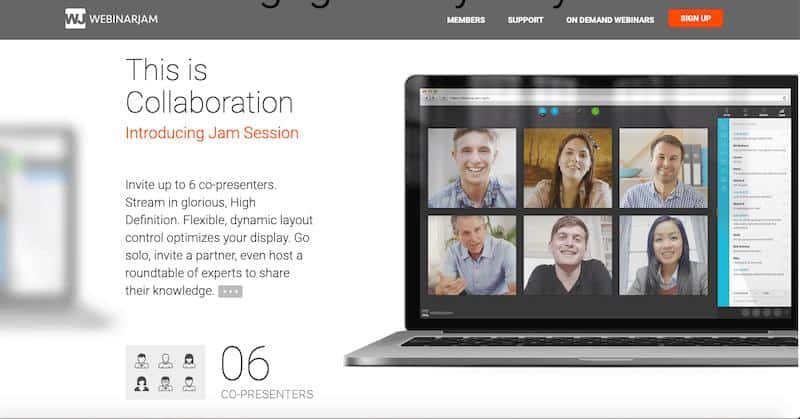
They allow you to invite up to six co-presenters and even host a roundtable of experts to share their knowledge.
5. Webinar Software Helps Build Domain Expertise.
Webinars are personal interactions and can increase your domain expertise while connecting you with a new following.
As you continue creating webinars, more and more people begin to attend, you scale up your own brand recognition, pick up a lot of domain knowledge – plus soft skills about presenting and webinar management.
Being recognized as a thought leader and industry stalwart can improve customer retention and customer lifetime value for your business, which can help you boost sales in the long-term.
How Do You Effectively Use Webinar Software?
While a majority of online businesses are hosting webinars today, it doesn’t mean they are able to turn prospects into customers.
That’s the reason why most webinars see get a high conversion rate.
Statistics suggest that webinars have a 35% to 45% registrant to attendee conversion rate. And after that, most webinar hosts expect a single-digit conversion rate.
What you need is a competitive advantage over your competition by creating and providing value.
Thus, strategizing how to best use your software is paramount. The right webinar plan, used in the right place at the right time will make all the difference.
Here are a few tips to help your webinars stand out:
1. Research Your Audience.
The eventual goal of your webinar is to generate leads and make them purchase your product or services.
Thus, you need to know what type of people are joining your webinar platform.
Before you host the webinar, it’s decidedly useful to conduct thorough research on the type of people that are attending, their demographics, professional domain and expertise, and industries they belong to.
It helps you get a brief idea about what your audience is expecting from you.
In-depth research about your audience will help you gauge precisely what they’re expecting from the webinar, vis-à-vis the current market scenario.
There are some of the ways you can use to gather information:
- Conduct surveys
- Do online research
- Find customer data
- Collect additional information via your webinar registration page
Here’s a webinar registration page by KISSmetrics:
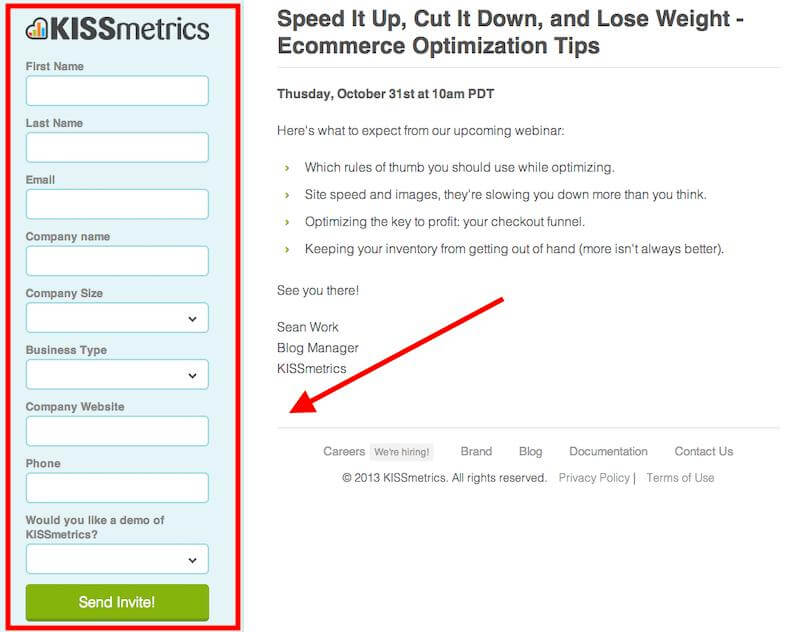
On this registration form, they ask some pertinent questions that will help them gauge what type of audience is going to attend their webinars.
Identifying your customer needs is a great way to bolster the conversion rate of prospective leads into customers.
2. Visual Branding.
According to statistics, people are likely to retain only 10% of the information that they hear three days later. However, pair a relevant image or visual aid, and the retention rate shoots up to 65%. That’s why involving visual branding in webinars comes in handy when it comes to generating more leads.
The creation of visual branding, like the insertion of a logo, tagline, etc. can go a long way in ensuring brand recognition and retention. These brand elements provide cues about your brand, for days after attending the webinar, which can only work in your favor.
Repeating the same visual styles for subsequent webinars help build the brand image in the mind of the customer, so that they slowly begin to associate themselves with you, building up brand loyalty in the process.
Many webinar hosting providers help with your visual branding in just a few clicks.
LiveWebinar is one such example.
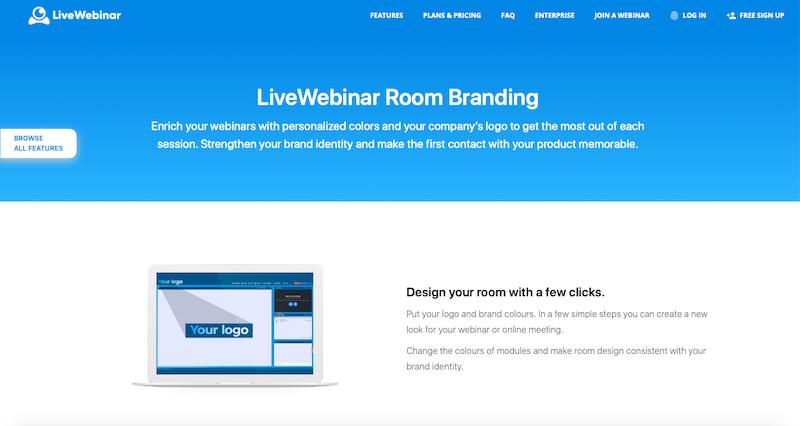
LiveWebinar provides excellent visual branding options to help you strengthen your brand identity and get the most out of your session.
This includes creating custom branding in your pre-event emails, webinar waiting rooms, presentation, and follow-up.
3. Leverage Analytics.
It is essential to leverage analytics to understand what kind of message your audience is most responsive to.
There are also plenty of analytics tools like Google Analytics and Facebook Insights that can provide you with a far more detailed, customized, and personalized breakdown of traffic on your webinar concerning a variety of parameters.
Each business is unique and cannot be predicted based on your competitors or peers.
With analytics, you get data specific to your business that is aimed at maximizing the potential of your webinars.
Many webinar platforms, like EasyWebinar, come with in-built advanced analytics reporting tools.
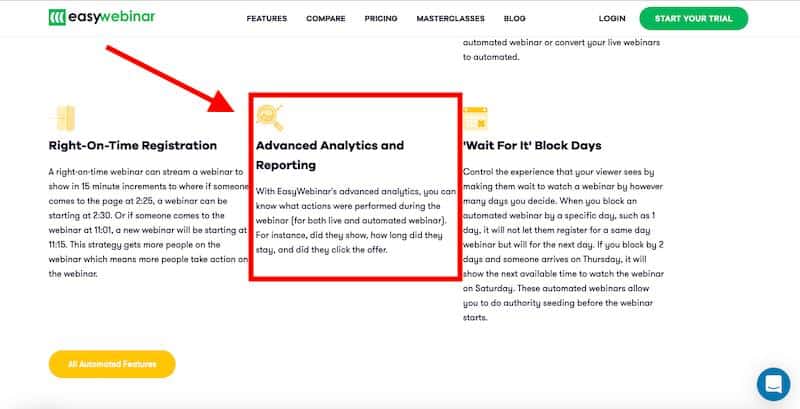
It helps you understand what actions did your audience performs during the webinar (for both live and automated webinars).
4. Keep Your Webinar Succinct.
Not many viewers want to stick around for an hour to listen to you talk.
In fact, recent studies show that 41% of attendees prefer webinars of 30 minutes, and 44% prefer webinars up to 45 minutes long.
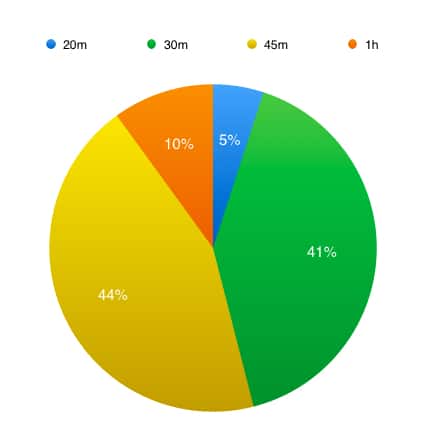
Additionally, more than 80% of viewers look for webinars under 45 minutes, which clearly suggests that most webinar participants prefer shorter, valued-added sessions.
It points towards another strategic consideration: having the right content to sell.
A long, convoluted speech is unlikely to work successfully here. Your goal should be to talk about things that can be easily demonstrated and are easy to understand.
And the emphasis should be on wrapping it up within 45 minutes and entering your sales pitch for the best results.
5. Well-Timed Promotions.
Suppose it’s the weekend and a 50% discount flash sale got announced for 2 days only. There’s a real sense of urgency.
However, if the announcement was made over two months ago, no one will remember it when the time comes.
Now, let’s suppose you heard about the sale only last week. Would you remember it now? Probably, yes.
It turns out, the time and day of the webinar are not the only significant influences on attendance. The date of the announcement of the webinar is another essential factor in the registration rate.
The Webinar Benchmarks Report found out that 25% of registrations occur on the day of the webinar, whereas 23% of registration occurs more than two weeks before.

You should also plan to announce your webinars numerous times before launch, including via emails, social media, and other teasers.
Making a short promotional video and uploading it on to your social media sites, Reddit, or YouTube accounts can also bring in large numbers of attendees.
On the other hand, if you’re looking at promotional emails and sending out invitations by email, some specific days are more effective than others.
As per the same webinar report, Tuesday, Wednesday, and Thursday are the best days to send promotional emails.

Remember, simply promoting your webinar isn’t enough. With so much competition in this online space, using the best webinar marketing strategies is vital.
Webinar Software – Summary.
Owing to their impressive and user-friendly features, these are some of the best webinar tools available today.
But the question is which webinar software platform is best for your business. To identify this, you need to take several things into account. For starters, see what your budget is and then compare the features accordingly.
Then you need to identify what size your audience is and what features you might require to engage them. Also, consider things like what features do you need during the event?
What’s your end goal? Do you want to boost your conversion rates or need to conduct a poll/survey? It’s crucial to select the tool that offers the specific features you need.
The best part is that most of these tools come with a free trial or money-back guarantee, which allows you to test out the product before upgrading to a paid plan. When you find what you are looking for, then you can make the final purchase.
If you’re looking for my top pick, I recommend you get started with Livestorm for free.

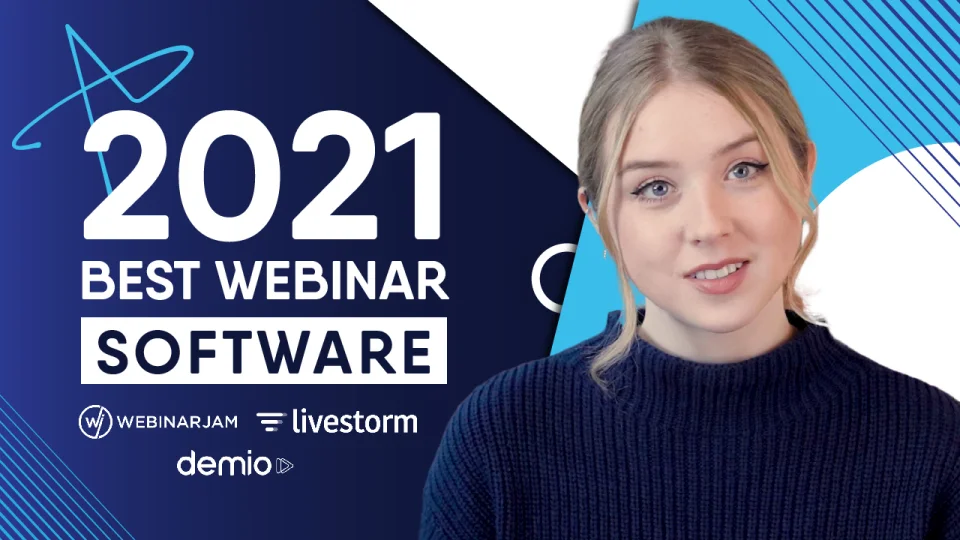


Average Rating